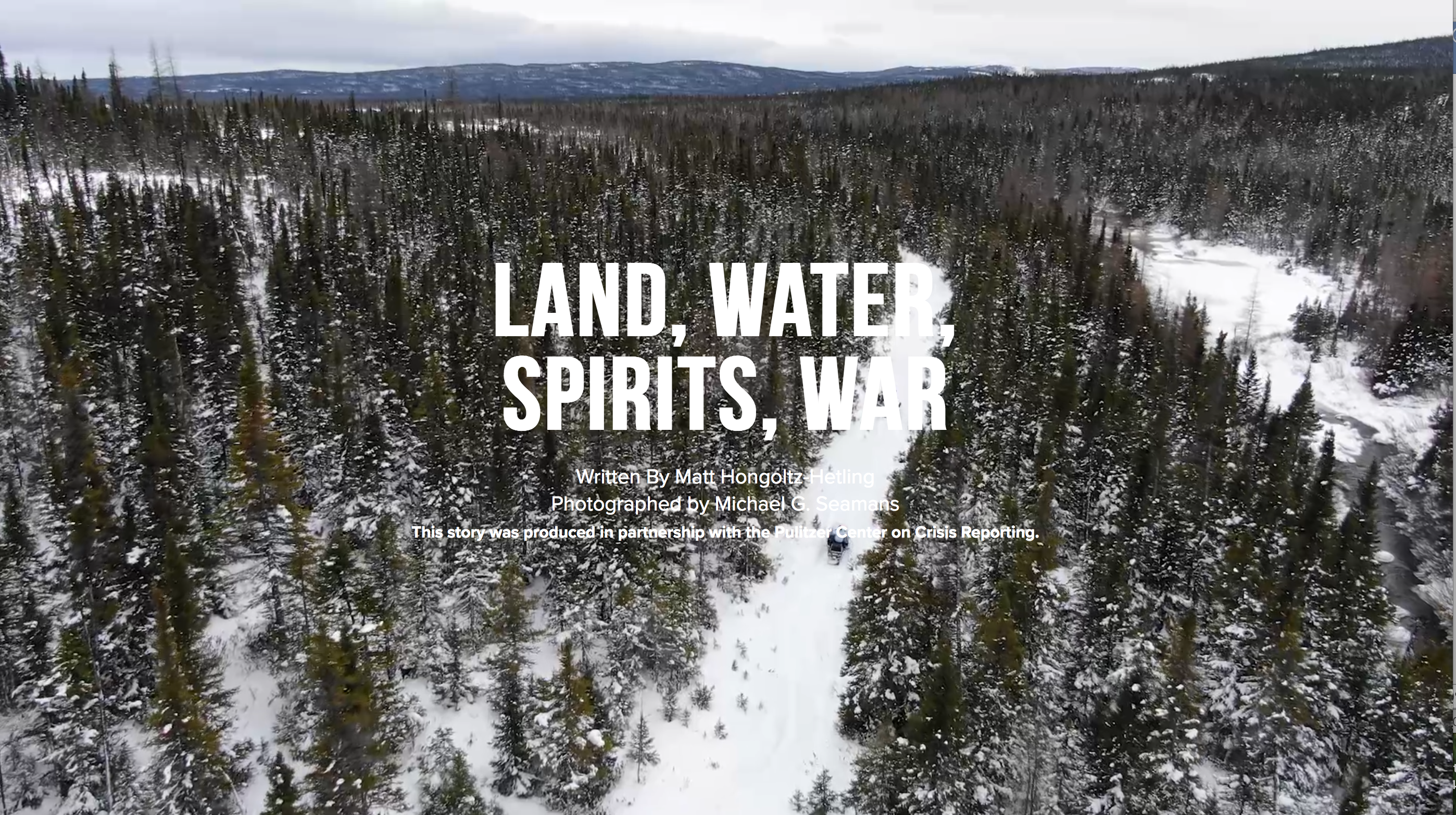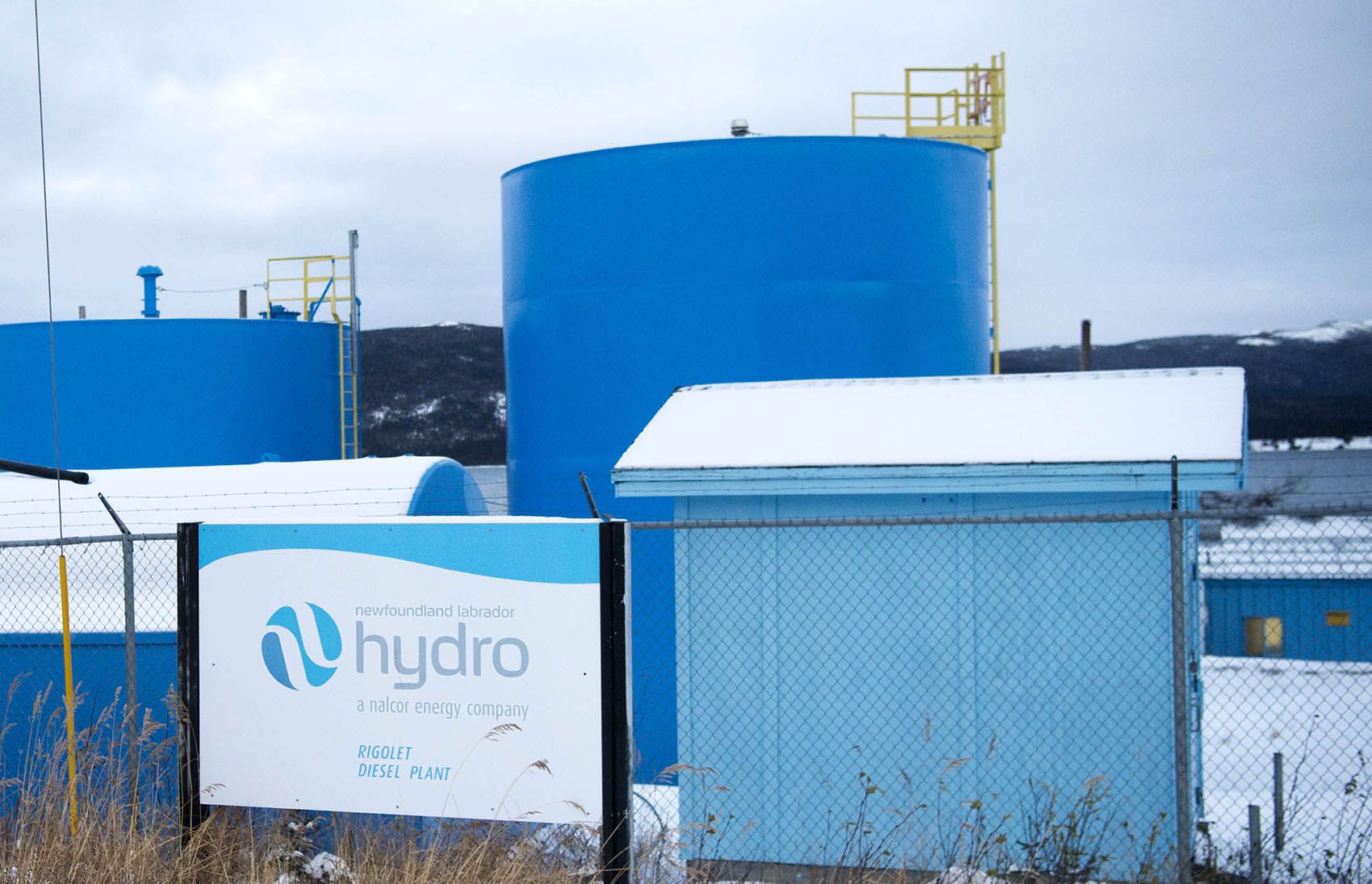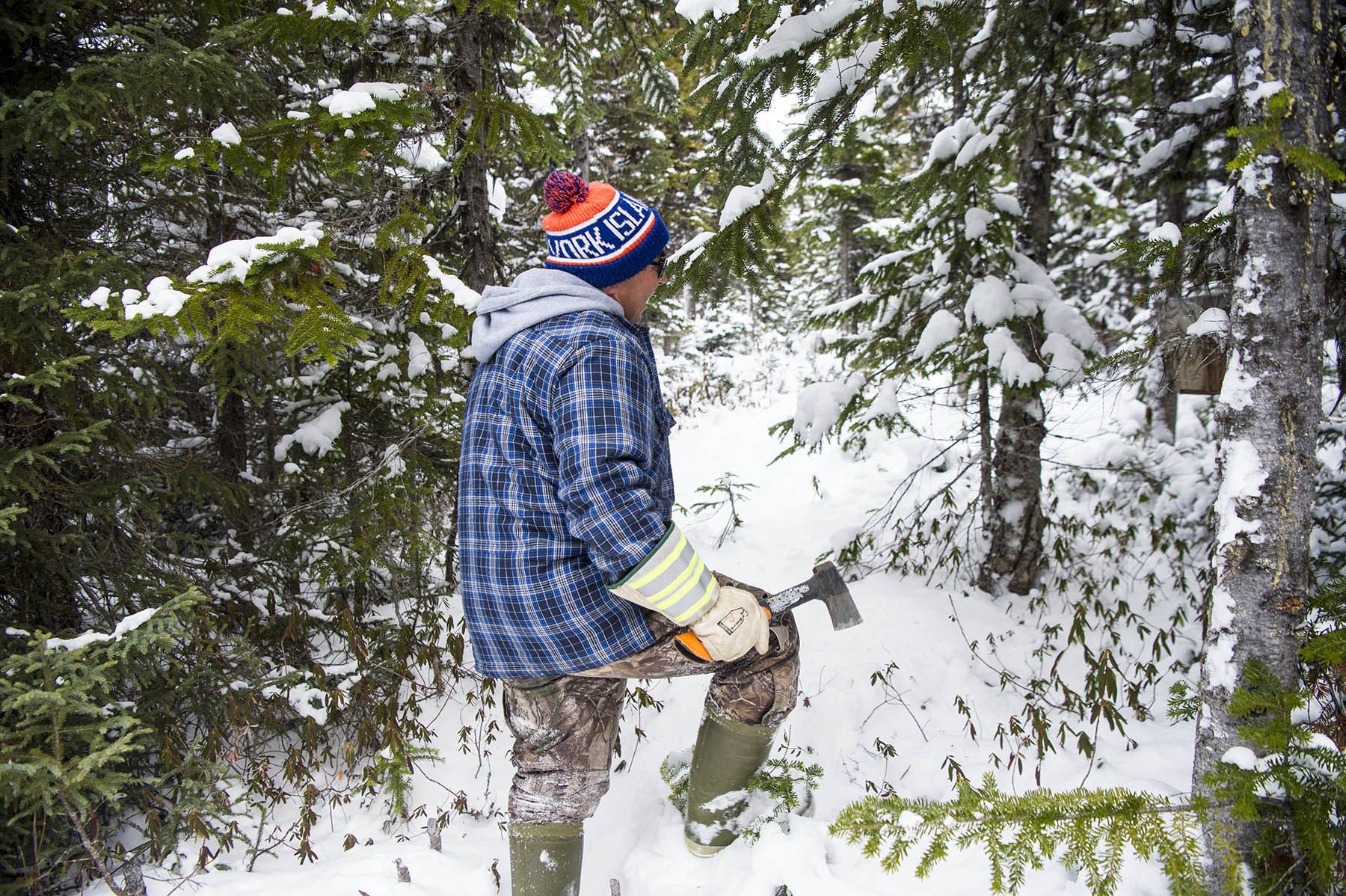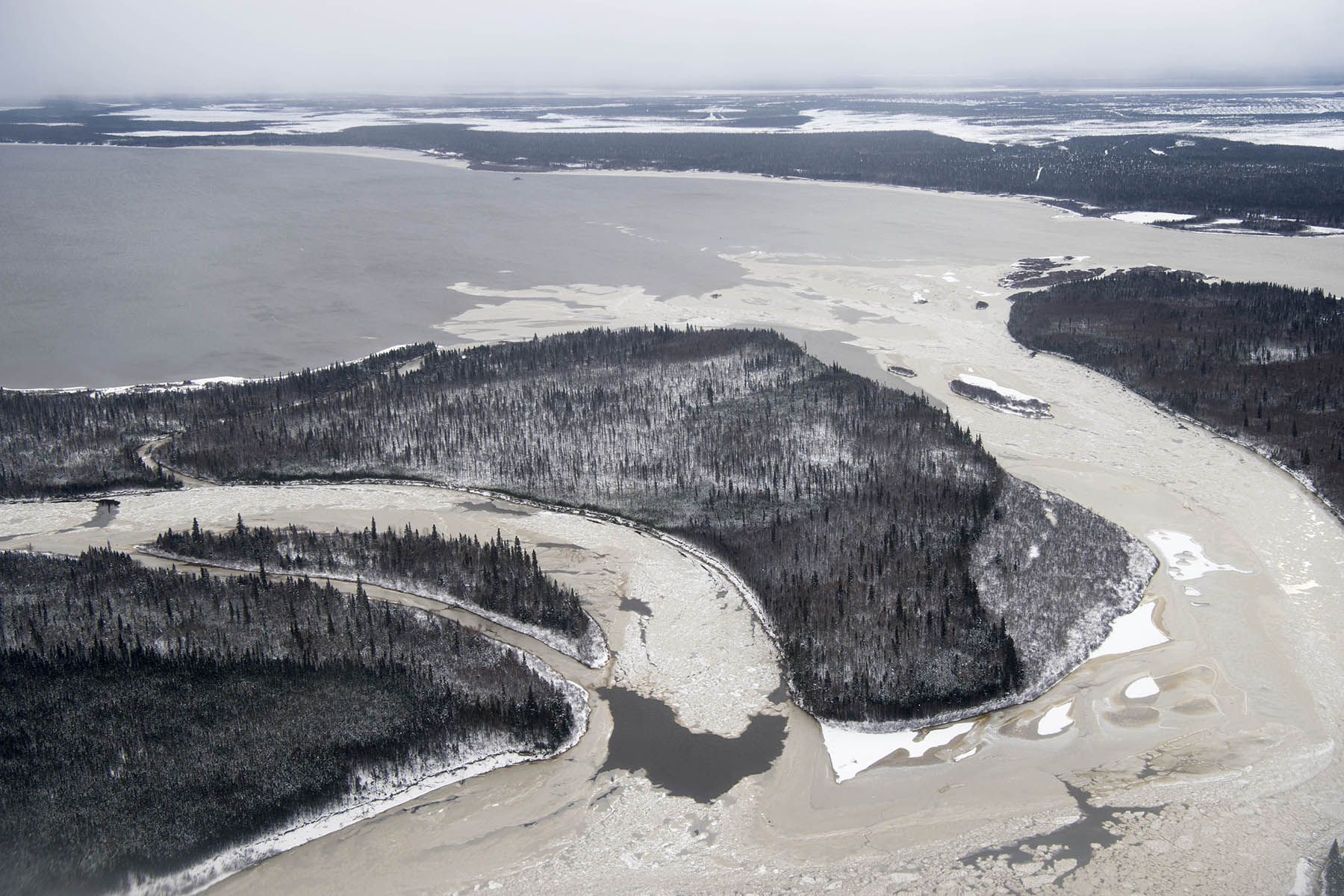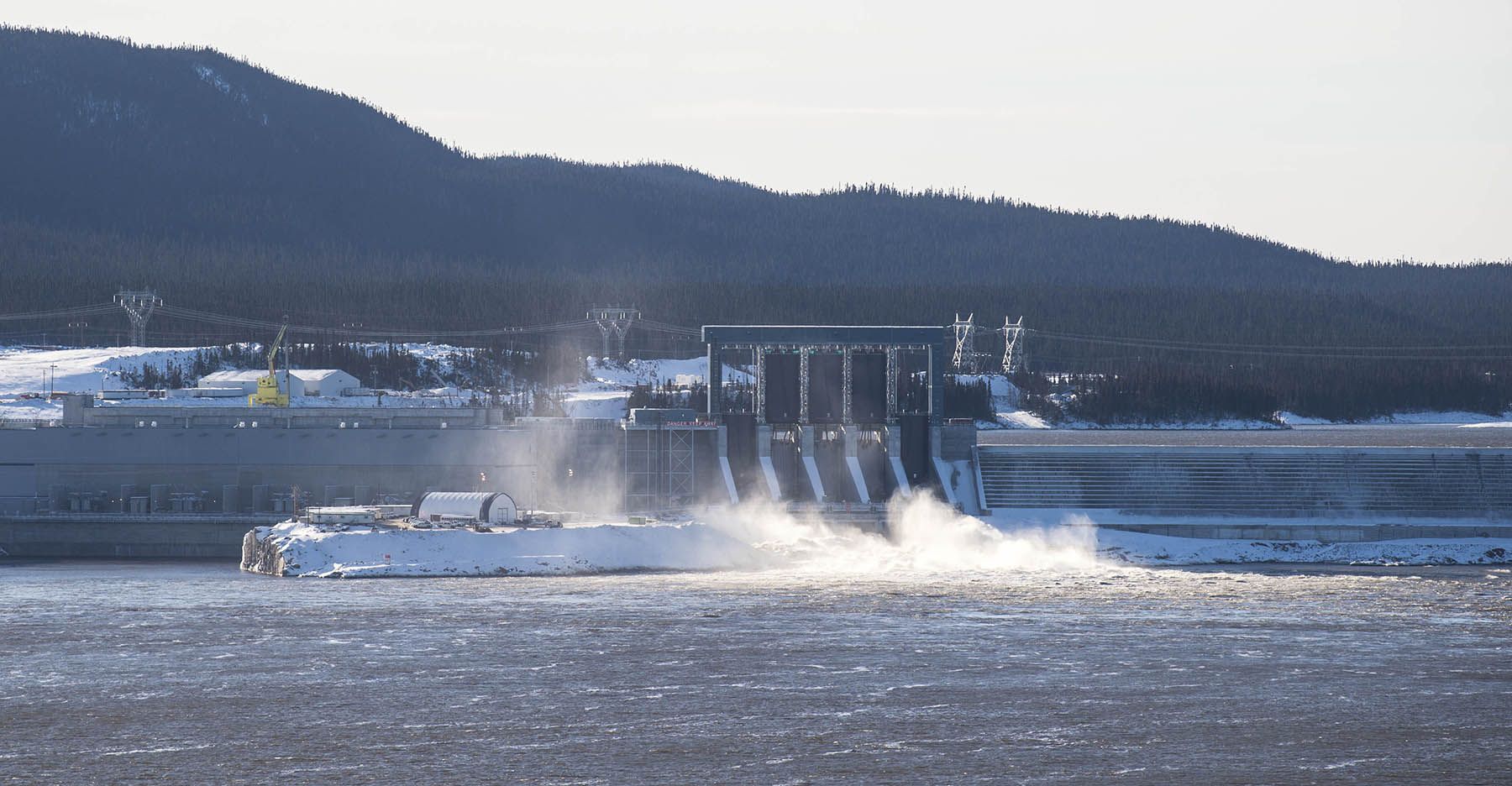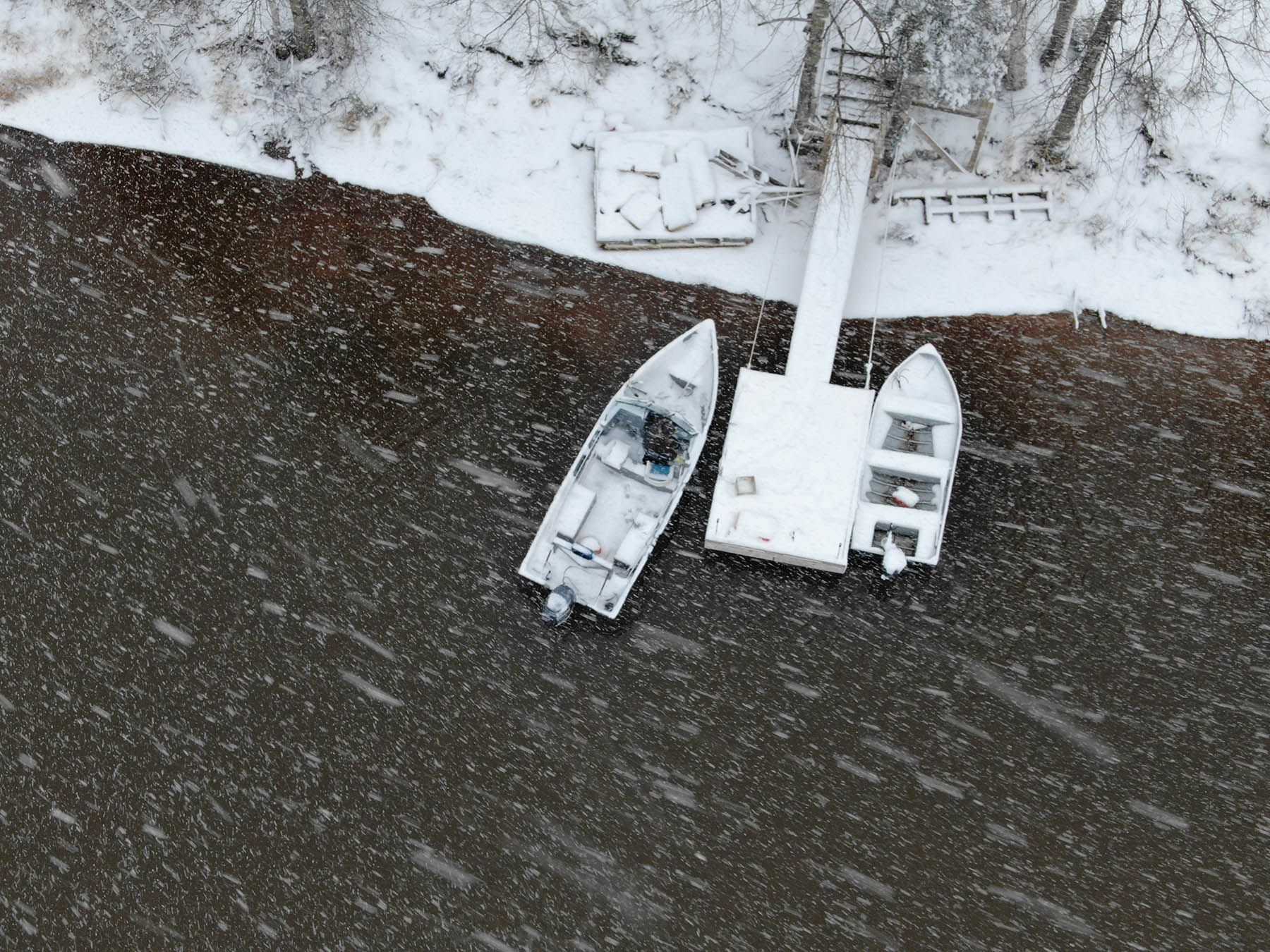As an endless parade of white snowflakes melted into the gray water of the harbor outside David Wolfrey’s living room window in Rigolet, Labrador, he spoke of his childhood.
“I was afraid,” the 59-year-old said, in a flat, matter-of-fact tone. “That they were going to attack me, and stuff like that.”
Wolfrey was describing his fear of animals, which followed him beyond his days as a slim, pensive teen and into his 20s, when he eked out a sometimes-nervous living by trapping marten, fox and lynx for their furs.
Fear of animals may seem appropriate in the coastal tundra, where pods of killer whales — alluk— and roaming polar bears — nanuk — are the norm, but it was at odds with a tradition of stoicism among the Inuit who, after thousands of years in this rugged crucible of ice, remain unbroken.
Rigolet is the southernmost Inuit community in North America, sited where the fresh waters of Lake Melville flow into the salty Labrador Sea. Over the past decade, residents like Wolfrey have been fighting against a new threat, one they see as more treacherous than rotting ice over turbulent waters, and more insidious than the seductive heat flash of late-stage hypothermia.
Less than 100 yards from Wolfrey’s front door, one of Rigolet’s only fences encircles a property dominated by a pair of house-sized diesel tanks, painted a brighter blue than any of the 60 or so homes in the small Inuit community. A sign identifies the tanks as the property of Nalcor, a large energy company owned by the Canadian province of Newfoundland and Labrador.
Wolfrey says hydropower exports to the United States, which earn state-owned companies like Nalcor $3 billion each year, come at the expense of irreversible environmental and cultural damage to indigenous communities like Rigolet.
Sometime this year, Nalcor plans to achieve a longstanding goal: to supply 98% of the Newfoundland and Labrador province with renewable energy.
But to Wolfrey, the massive diesel tanks outside his home are a bitter reminder that the marginalized Inuit remain in the 2% who are not scheduled to share in the bounty.
“You can look out my window right next door, and the diesel plant is there,” Wolfrey said. “And it’s all black smoke coming out of it. You know?”
And then, with no change of tone: “I just get mad.”
Triumph and Tragedy
Contrary to popular belief, large scale hydropower facilities do emit greenhouse gases, in part because forests rot when they’re flooded, releasing methane and carbon. But because the carbon footprint is still, according to the upper range of estimates, only about half that of natural gas, (according to a 2012 analysis commissioned by the Conservation Law Foundation), Canada’s conversion to hydropower is often seen as a triumph for both global environmentalism, and the Canadian economy.
From modest beginnings in the early 1900s, Canada’s hydropower industry now boasts a massive array of 500 generation facilities that supply about two-thirds of the nation’s electricity, making it the third-largest producer of hydropower in the world. And over the next 20 years, Canada’s hydropower industry is expected to receive $125 billion in funding and create 1 million jobs.
That rosy outlook relies on increased support from energy markets in the U.S. which, by 2014, was already buying 10% of Canada’s electricity, receiving the flow of power over 30 international grid interties, mostly in the Midwest and Northeast. And although President Donald Trump has withdrawn the U.S. from the 2015 Paris Agreement, Canada sees a robust growing demand from state governments that are still hungry for renewable resources like solar, wind and hydropower.
But to Inuit like Wolfrey, the century-long ascendance of Canadian hydropower is viewed through a different lens, as part and parcel of a dark era of exploitation and forced assimilation of indigenous residents.
Legislation like the Indian Act of 1876 banned traditional religious practices and invalidated tribal government structures. Between the 1930s and 1960s, spiritual leaders — angakkuit — were driven underground, while parents watched their children become strangers under the tutelage of distant residential schools. Communities were compelled to abandon their nomadic, sustainable way of life in favor of permanent residences and a wage-based economy.
The effect on Inuit culture has been devastating — while 92% say speaking their aboriginal language is important to them, just 25% can hold a basic conversation in Inuktitut. The life expectancy for Inuit is 10 years less than non-indigenous Canadians; 42% of adults lack a high school diploma, and 61% of Nunatsiavut households experience food insecurity
Academics, like Michael Kral of Wayne State University, have published research linking “colonization, dispossession, culture loss, and social disconnection” to one of the highest suicide rates in the world, 10 times that of Canada as a whole.
Wolfrey’s disquiet around animals was one small expression of his generation’s disconnect with traditional Inuit practices. Had he been raised in a traditional setting, an angakkuq would have instructed him in the inua, a life force the Inuit believed resides within, not only each individual Inuk, but every animal, plant, lake and mountain. This worldview, in which humans are just one component of the natural environment, underpinned a culture that valued sustainability over exploitation of natural resources. Inuit subsistence hunters once honored the inua by, for example, squeezing a bit of water into the mouth of a dying seal, to ease its passage into the afterlife.
Though such practices have waned, many modern Inuit are working against continued cultural erosion by clinging to their most robust remaining connection to the past: hunting, gathering and fishing their food from the land. Wolfrey’s own reclamation of his spiritual connection to his heritage was aided by an experience he had while working his trapline.
To trap animals, Wolfrey first crosses Lake Melville to get to Otter Pond, where he literally walks in the footsteps of his father and grandfather, who ran the same trapline when they were alive. Sometimes, he pauses in the spine-numbing cold to take in the vast open horizon, where the Northern Lights have painted the sky for countless generations of Inuit.
One day, when he was in his early 30s, Wolfrey was inspecting a trap when he suddenly felt that his father, who had died 20 years ago, was near. Wolfrey says his father’s spirit bore a message.
“He let me know I’m okay on the land,” Wolfrey said. “I don’t have to be afraid of nothing.”
In a moment, Wolfrey’s longstanding nervousness around animals evaporated, replaced by a feeling of deep empathy for the land. That the experience came while working in the wilderness was no coincidence, said his wife, Charlotte Wolfrey.
“People have a creator,” she said. “And I think to the Inuit, the land is our creator. … It helps us connect to our ancestors, when we’re out there on the land.”
In late 2005, the Inuit of Labrador suddenly found cause for hope that they’d turned a corner — 130 years after the Indian Act began formally dismantling Inuit culture, the Canadian government recognized the Inuit’s right to control a large chunk of the Labradorian coast, and to elect an autonomous Nunatsiavut Government — nunatsiavut, in Inuktitut, means “our beautiful land.”
After centuries of watching the land suffer commercial harvests and large scale developments, the Inuit of Labrador would finally have a chance to bring their ancestral ethos of stewardship into a modern regulatory setting.
But that newfound optimism was almost immediately put to the test.
In May 2006, just six months after the fledgling Nunatsiavut government began pursuing an IQ-influenced regulatory framework, Newfoundland and Labrador Premier Danny Williams announced the province’s intention to develop the lower Churchill River by creating two new hydroelectric facilities.
Though the first of the planned dams, a $12.7 billion project called Muskrat Falls, would be sited 120 miles away from Rigolet, Wolfrey and his Inuit neighbors worried that it would wreak havoc on their local ecosystem.
The Churchill River is the biggest water source for Lake Melville, which drains Labrador’s largest watershed. Rigolet’s traditional hunting and fishing practices are predicated on the wealth of species — seals, fish, and waterfowl — that converge on its boundary, between salt and fresh waters.
Hunting Nanuk
Around 2009, well before the ice went out for the season, Wolfrey’s snowmobile broke fresh tracks across the snowy tundra, his adult daughter following behind him. She had asked him to take her on a polar bear hunt.
“Oh yes, we eat the polar bear,” said Wolfrey, recalling the story. “Some people keep the hide, and some people sell the hide.”
The hunt was taking place at an exciting time for the Inuit of Labrador.
By the time he embarked on the polar bear hunt with his daughter, Wolfrey’s comfort on the land had allowed him to take a job as a conservation officer in the Nunatsiavut natural resources department, which developed hunting regulations based on each household’s need for meat. Rigolet was allowed to take two polar bears, and five moose, each year.
Though Wolfrey’s daughter had long known how to skin the takings of his traps, he was excited to teach her to skin an animal that can weigh well in excess of 1,000 pounds.
The snowmobiles had first carried them about 17 miles from Rigolet, to Fox Island. Most Inuit maintain seasonal shelters to support hunting and fishing activities, a vestige of their nomadic days. Here, Wolfrey’s nephew maintained a traditional Inuit camp — an aullâvik — where they kindled a fire in the woodstove of a cabin. They’d spent a couple of days patrolling the region and looking for signs, before a raging snowstorm forced them to take a day off.
Now they were out again, in a blinding white land that seemed to have been reborn into a state of frozen, pristine perfection. She spied the nanuk before he did — a real prize, easily 9 feet tall, but loping across the snow-covered tundra and out toward the sinâ, where the ice met the sea.
The Inuit once saw only a vague distinction between themselves and polar bears, believing that polar bears could take off their skins to become human, while angakkuit could put on skins to become bears. Oral histories emphasized how the polar bears lived in igloo-like caves of snow, and employed sophisticated hunting techniques, like hurling blocks of ice to subdue walruses, or camouflaging a black nose behind a white paw while creeping along the ice toward an unsuspecting seal.
Descriptions of these unusual hunting practices, which have never been documented by scientists, are just one example of a body of traditional Inuit knowledge, also known as Inuit Qaujimajatuqangit, or IQ. Other examples of IQ involve seasonal movements of different species, and meat preparation methods that stave off vitamin deficiencies.
These were the sorts of insights that were making the Nunatsiavut government’s environmental framework unique among the world’s modern legislative bodies.
Nunatsiavut legislators developed a “decision support system” that would amass and translate IQ into a format that would make it useful to policymakers. The 33-page Nunatsiavut Environmental Protection Act uses the phrase “Inuit Knowledge” 24 times, and requires that it be a major part of decisions about the use of natural resources. And the Inuit also brokered an agreement with the Canadian government to use traditional knowledge in a sweeping marine management plan, which would protect a stretch of the Atlantic coast — nearly 150,000 square miles of water — from increased shipping, oil and gas exploration and commercial fishing.
But it’s unclear whether, as the polar bear hurried away from the snowmobiles, Wolfrey’s next words to his daughter were born of IQ, or simple common sense.
“We got to try to get the polar bear before he gets out to the water,” he said. The closer the bear got to the open water of the tagiuk, the less certain they would be of a clean kill, and of recovering the body.
Using their snowmobiles and maintaining a safe distance, they placed themselves between the bear and the water, herding it back toward solid land. The bear, agitated by the thrum of the snowmobile engines as the Wolfreys blockaded its path, retreated behind a clump of ice as big as a school bus. Thinking quickly, Wolfrey handed his rifle to his daughter.
“I’ll get the polar bear to walk around,” he said, and took off around the outcrop of ice, intending to flush the bear so that she could get a clean shot.
But the bear had its own plans. When Wolfrey rounded the ice, out of sight of his daughter, he found it waiting for him, back hunched in defiance of his revving motor. The closer he got, the more easily Wolfrey could see that he had underestimated the size of the bear — it was fully 11 feet, and glaring at him.
“I were only about 20 feet away from the bear,” Wolfrey said. “Oh yes, you could hear it growling.”
And as quickly as he thought to reach for his gun, he remembered that he’d just given it away.
Modern Policy, Ancient Beliefs
Meanwhile, Rigolet and the other Inuit of Labrador were grappling with a sense of deep unease that grew stronger as Premier Williams and Nalcor continued to pursue Muskrat Falls. Their newly minted Nunatsiavut government had no jurisdiction over the project, because the Churchill River lay on the lands of another indigenous group, the Innu.
For the first few years, it seemed like the Inuit and Innu had common interests. Both groups were still suffering the downstream effects of Churchill Falls, a 1960s-era project that state-owned companies in Quebec built higher up on the Churchill River. That $1 billion project constructed 88 dykes to flood 1,900 square miles of traditional Innu hunting grounds, forever transforming the Lake Melville ecosystem.
Wolfrey’s Rigolet neighbor, Karl Michelin, says the dam interfered with his parents’ ability to hunt and fish.
“There’s less current coming out from that big river anymore,” he said. “There’s a lot of animals that aren’t going to want to come into this bay anymore. That’s what happened to the salmon.”
As economic and political forces build an infrastructure that will further disrupt Canada’s hydrologic cycle for the next century or more, indigenous residents across the continent have worried about how their natural food supply might be affected by methylmercury poisoning.
Scientists are still learning about the relationship between dams and methylmercury. They know that a stable forest ecosystem prevents elements like carbon and mercury from entering the atmosphere and water, by locking both materials up in its wood, soil and vegetation.
But when land is flooded, much of that mercury is washed into the water column, where aquatic bacteria take it up and transform it into methylmercury, a toxin that can cause severe damage to the brain and nervous system. The toxin is passed up the food chain, bioaccumulating in larger animals, including the fish, seals, waterfowl and polar bears that the Inuit rely upon for food.
Rigolet residents already have, on average, about twice as much methylmercury in their bodies as the Canadian population as a whole, in part because of their heavy reliance on wild-caught foods like salmon, cod, trout, ducks and seals from waters downstream of the Churchill Falls project.
Wolfrey and his neighbors worried that Muskrat Falls would increase contamination to the point that it would drive a wedge between them and their ancestral lands.
“It’s destroying our food source and also our culture,” said Wolfrey.
But there is sharp disagreement over whether the Inuit fears would be borne out. In response to concerns, Nalcor conducted a widespread study that included collecting dietary data and testing hair samples and local waters for methylmercury. Nalcor’s findings suggested that Muskrat Falls would do little to threaten public health.
“What we’re predicting is that there will not be an impact,” a spokesperson for Nalcor told me. And Hydro-Quebec, another state-owned hydro company, says that even the elevated levels documented in Rigolet are only about a fiftieth of the levels that have been shown to create measurable health effects.
But other researchers have asserted that health impacts are associated with the tiniest detectable traces of methylmercury. A team of researchers from Harvard and Duke universities collected their own data, and created a model that led to very different conclusions than Nalcor.
“Under (the worst of two possible scenarios), up to 46% of residents exceed the Health Canada guideline for adults and 66% of residents are above the U.S. EPA reference dose,” wrote the researchers.
The assurance of Nalcor and the government have done little to allay concerns among the Inuit, in part because of a dismal track record of exploiting indigenous resources for profit. Wolfrey calls the dams “money greed projects.”
Over the past several decades, the dams have flooded traditional hunting grounds, fragmented caribou habitat, eliminated populations of salmon and other migratory fish from rivers and lakes, disrupted trap lines and undermined entire ecosystems by altering the natural hydrologic cycle.
In many cases, the rights and objections of indigenous groups, whose location and ties to the land leave them vulnerable to such developments, have been steamrolled in service of the national interest.
Damming projects are now subjected to more stringent environmental reviews, but they are still part of “systemic failures to assess the impact of multiple resource development projects on Indigenous territories,” according to findings published by First Nations and University of British Columbia researchers.
The Inuit of Labrador worried that Muskrat Falls — which was criticized by the United Nations for its lack of Inuit involvement — would continue the pattern of large scale hydropower development at the expense of indigenous communities, and would further disrupt their way of life on Lake Melville.
Their fears were deepened in 2008, when Innu Nation used the leverage of its recognized land claims to the proposed Muskrat Falls to negotiate the New Dawn Agreements with Nalcor. The deal included a financial package that compensated the Innu with hundreds of millions of dollars for the loss of their traditional hunting grounds, and for the damage they suffered under the Churchill Falls project from the 1960s.
That deal gave Nalcor an indigenous partner on the project, and left the Inuit, with their new government and all of their IQ-informed environmental aspirations, more isolated in their opposition to Muskrat Falls.
But they were not ready to give up the fight.
Respect and Reward
When the polar bear confronted the unarmed Wolfrey, he was forced to grind his snowmobile to a halt. The nanuk advanced a step, scratching at the snow aggressively, as Wolfrey’s daughter, out of sight, waited for the bear to come out on the far side of the ice clump.
A younger David Wolfrey would have been terrified, perhaps even panicked into taking a rash action, such as speeding past, shouting, or revving his engine in an effort to intimidate the bear.
But now he was changed, not only by the experience with the spirit of his father, but by a broader set of spiritual awakenings. He had fasted in isolation in the wilderness. While asleep, he had walked Rigolet’s beaches with his ancestors, admiring their hand-crafted kayaks and harpoons. He often received visits from the spirits of the animals that approached his traps; when Wolfrey woke in the morning, he already knew whether his traps were empty or full.
“When I’m out on the land by myself, when no one else is out there … It’s just me and the land. I can feel the connection with my grandparents, and my dad, and my mom.”
If the land connected him to his heritage, his heritage connected him to the land, including the sky above, the snow below — even the bear edging closer.
The angakkuit of times past might have said that what happened next was a show of mutual understanding between inue. Breathing steadily, Wolfrey backed slowly — respectfully — away from the bear. It stopped advancing, and only watched warily.
Once Wolfrey had put enough distance between himself and the bear, he swung his machine around and reunited with his daughter.
In Inuit legend, a polar bear avoids disrespectful hunters by changing itself into an owl, a white fox or a clump of ice. But a bear treated with deference rewards the hunter by allowing itself to be killed, gifting the hunter the meat of its body while going on to its own rewarding life in the spirit world.
When Wolfrey and his daughter went roaring back behind the ice clump, this nanuk was still there, flesh and blood, and it broke in the direction they wanted, back toward the land. Within moments, Wolfrey’s daughter brought it down.
The rest of the day was spent in backbreaking labor, as father and daughter undertook their long-awaited lesson in skinning, beginning with incisions along the paws, chest and jaw. It took hours to dismember and transport the hide, meat and edible organs of the half-ton carcass.
When they returned home, they reported the kill to the Nunatsiavut government and put some of the meat in a community freezer that, in keeping with another Inuit tradition, is well-stocked.
“They have moose, char, salmon, berries, partridges, all sorts of wild meats,” said Wolfrey. “So people who can’t get out and get their own, they go to the freezer and get theirs.”
That culture of sharing, which evolved in a subsistence environment, is still critical in Northern Inuit communities, because their remoteness strains the Western tradition of transporting mass quantities of processed food over great distances.
Rigolet does have a store with a standard array of groceries. It’s located just past the diesel tanks outside Wolfrey’s home. But the cost of the food, which arrives by boat or plane, is prohibitive.
Even after applying a government subsidy designed to address rampant food insecurity among the Inuit, a dozen eggs costs $4.50, a pound of butter goes for $8, a half-gallon carton of orange juice is $12, and a modest shoulder of smoked pork is $55.
The high prices are one reason that most Rigolet residents get most of their food from hunting, fishing and gathering things like the eggs of shorebirds and berries.
Wolfrey, and most others, see this as a good thing — as long as there is a constant incentive to hunt and gather food, their connection to the land will have space to flourish.
But Wolfrey’s satisfaction with the successful conclusion of his polar bear hunt was tempered by worry that, after centuries of persevering in such activities, flooding of 15 square miles around Muskrat Falls could prevent his daughter from passing her newfound knowledge on to the next generation.
Battle for Muskrat Falls
As planning for Muskrat Falls proceeded, the Inuit joined with environmental groups and disaffected people in other communities along the Lake Melville watershed — Happy Valley-Goose Bay, a mixed community of about 8,000, and the Innu communities of North West River and Sheshatshiu — to engage in a wave of protests that, over several years, escalated from simple sign-waving to hunger strikes and acts of civil disobedience, such as trespassing onto the proposed dam site to perform drum ceremonies that celebrate the land.
“We fought against it,” he said. “The Inuit people, we fought hard.”
As the protestors grew more daring, Canadian authorities responded with targeted arrests, including of Wolfrey’s wife, Charlotte.
In the fall of 2016, hundreds of indigenous people established a permanent camp at the worksite, where they blockaded construction vehicles, prompting arrests and accusations of police brutality that gained widespread national media attention. After a week of unrest, at about 1:30 one morning, Nunatsiavut government leaders announced that they had struck a deal with Dwight Ball, premier of the province.
The protest was at an end. Within 12 hours, the camp was broken down and left empty. Social media posts from activists crowed about the victory, while a hunger striker posted a picture of his first meal in two weeks — local-caught char.
Though Muskrat Falls would move forward, the key concession won by the Nunatsiavut was how to address the methylmercury impacts, which the Harvard study said would be severe, and the Nalcor study said would be non-existent.
Under the new agreement, an independent expert advisory committee would make recommendations about possible mitigation efforts at Muskrat Falls, such as stripping mercury-laden vegetation and soil from the land, or capping wetlands to prevent mercury contamination before flooding.
The Nunatsiavut leaders, intent on injecting IQ into the process, negotiated that the committee would weigh “the best available scientific research and Indigenous knowledge,” and that it would rely upon a panel of six scientists and three indigenous knowledge experts.
David Wolfrey was one of those three experts. As the panel came together for the first time in August 2017, Wolfrey was intent on protecting his food supply.
“I guess there would be food coming into the community freezers for us to eat, but that’s not who we are. We’re Inuit people,” Wolfrey said. “… It would be pretty sad if we couldn’t do that and seals are swimming along like 50 feet from the shore here and we can’t kill them because they’re toxic. I can’t even describe how I would feel about that.”
After months of data collection, the most contentious issue proved to be whether Nalcor should be compelled to remove 50 centimeters of soil from the proposed reservoir site, which it estimated could add as much as $742 million to the price tag of the project.
After hearing hours of sometimes-caustic debate and reviewing thousands of pages of research, three of the six scientists on the panel, including one representing Nalcor, recommended that no further mitigation be taken. A fourth scientist recommended capping the wetlands, while the other two scientists recommended both capping the wetlands and removing topsoil and vegetation from the area.
Without anyone representing traditional knowledge, that would have resulted in a majority opinion of no mitigation, but Wolfrey and the other two indigenous representatives — an Innu knowledge holder, and an Inuk hunter and trapper from Happy Valley-Goose Bay — all voted in favor of capping and removal, which tipped the scales.
“I represent Nunatsiavut,” Wolfrey said, in a brief written summary of his vote. “I know they expected for me to do what is best for the people, and that is what I thought was the best.”
Privately, Wolfrey said that his stance on Muskrat Falls has been tied to his relationship to family, and the land.
“My children’s children, my grandchildren, they’re not going to be able to live the life that I lived, and my grandparents lived,” he said. “I’m not saying we shouldn’t be going ahead in the world. But there’s ways they can do it without having big dams, big projects like that. There’s other ways that there can be green energy.”
To the Inuit, the recommendation, which was approved by a majority vote of the IEAC in April 2018, represented a major victory, and also served as a validation of blending traditional IQ into scientific views in policy making.
But the victory was short-lived.
Canadian news outlets reported that, immediately after receiving the recommendation, Environment Minister Eddie Joyce was unwilling to commit to a course of action.
Nalcor applied for a permit to undertake some of the vegetation removal and capping work in the fall of 2018, but the provincial government did not publicly engage the permit application until February 2019, by which time Nalcor said it was too late to undertake the mitigation project. Neither Nalcor nor the government were willing to delay Muskrat Falls, which was already under a dark cloud because, sometime between 2012 and 2017, its projected costs doubled, from $6.2 billion to $12.7 billion.
The cause for the inaction on the mitigation plan was not immediately clear. Public statements by Nalcor and the provincial government have suggested that it was a simple miscommunication — Nalcor was willing to do the work, but didn’t have permission, while the government didn’t understand the time constraints.
And so, in September 2019, as crowds of unhappy locals looked on, the land was flooded. The tips of treetops could be seen poking above the surface of the water, and an unmoored wooden cabin — perhaps an aullâvik — bumped up against the new dam. Beneath the water’s surface, invisible to the naked eye, the first bits of vegetation were beginning to rot, releasing their payload of previously sequestered greenhouse gases, and the first bits of mercury floated up out of the waterlogged soil. The Inuit and other locals, who had abandoned their civil protest on the promise that the IEAC would be taken seriously, were outraged.
That investigation is ongoing, though the Inuit say that the damage is done.
“We have always maintained that the Province had no intention whatsoever to cap the wetlands …,” Nunatsiavut President Johannes Lampe said in a public statement. “All we were told is that time simply ran out; that doing the work would have had a negligible impact on methylmercury production in the reservoir and the Lake Melville ecosystem. We have never accepted those claims. We still maintain the work could have been done prior to impoundment.”
These days, as the vegetation rots beneath the waters of the Muskrat Falls reservoir, Wolfrey tries to keep one eye on his grandparents, and one on his grandchildren, who already know the contours of his trapline.
“I take my grandchildren today, hunting and fishing,” Wolfrey said. “They love it. They love living-on-the-land days, the cabin.”
As a conservation officer, he ensures that young Inuit in the community grow up respecting the sustainable harvesting limits established by the Nunatsiavut Government, and teaches firearm safety and trapping courses.
While the groundswell of energy that supported the protests against Muskrat Falls has largely dissipated, the battle for the future of Canada’s indigenous residents continues. A 2016 survey of 22 planned future hydropower projects in Canada found that all 22 were within 60 miles of at least one indigenous community. One project, Gull Island, is slated for the Churchill River, and will flood 32 square miles of traditional Innu hunting grounds, possibly adding more methylmercury to the environment.
“We tried to stop it but we couldn’t,” said Wolfrey. “Now they’re talking about building another one next to it. Gull Island project. Which is going to be even bigger. It’s like nobody cares about the Inuit people and what we are here for, you know?”
And outside his living room window, the harbor swallowed another generation of snowflakes — frozen water from the lake, from the ocean, from the river, water that was here in the days that nanuk and inuk left the same light footprint upon the land. Water that will outlast the current political moment, outlast Wolfrey and Nalcor, outlast even the Inuit and the Canadian government— whether it is tainted by methylmercury or not.
